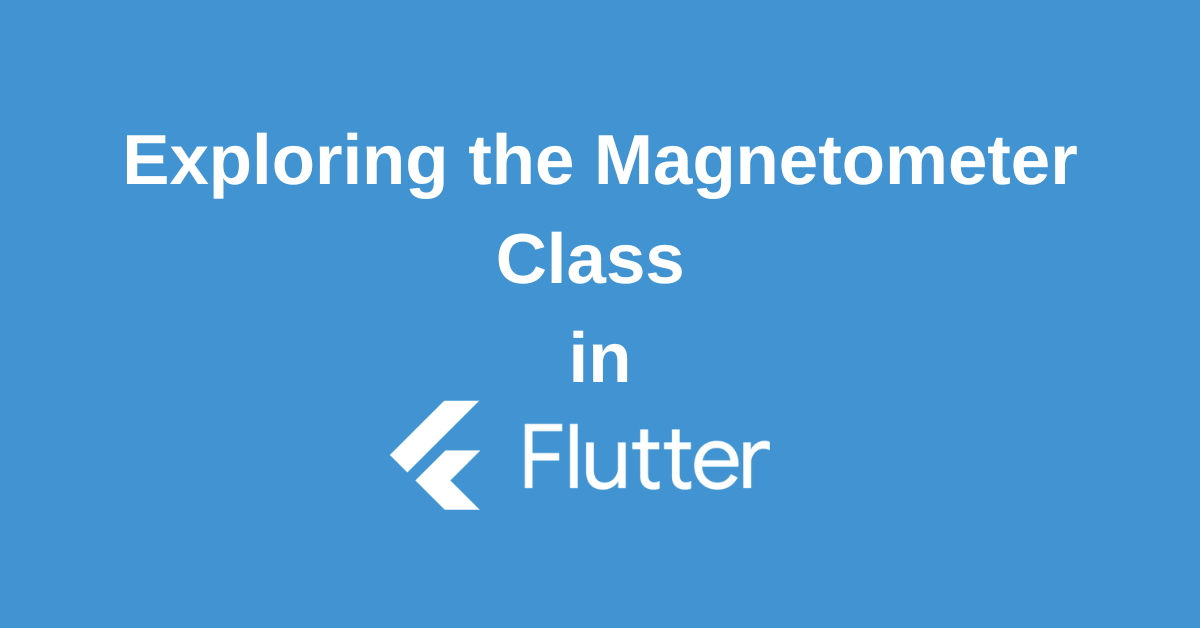Have you ever dreamt of adding real-world sensing capabilities to your Flutter applications? Imagine creating a compass app, a metal detector, or even an augmented reality experience – all leveraging the Earth’s natural magnetism. Well, with the Flutter Magnetometer Class, this dream becomes a reality! This powerful yet easy-to-use class unlocks the hidden potential of your smartphone’s magnetometer sensor, allowing you to incorporate magnetic field data into your Flutter apps and create innovative features.
Understanding the Magnetometer Class in Flutter
Flutter’s Magnetometer class is a gateway to magnetic field data, essential in navigation and interactive apps. Here’s a basic snippet to access magnetometer data:
import 'package:sensors_plus/sensors_plus.dart';
void getMagnetometerData() {
magnetometerEvents.listen((MagnetometerEvent event) {
print(event);
});
}This code sets up a listener for magnetometer events, printing the data as received.
Flutter’s Sensor Packages Overview
Building interactive and feature-rich Flutter apps often involves incorporating data from your device’s sensors. Thankfully, the Flutter ecosystem offers a wealth of sensor packages, with sensors_plus standing out as a popular and versatile choice. These packages simplify the process of accessing sensor data, providing intuitive APIs that make it easier for developers to integrate sensor functionality into their Flutter applications.
import 'package:sensors_plus/sensors_plus.dart';
void main() {
// Accessing different sensor streams
accelerometerEvents.listen((AccelerometerEvent event) {
// Handle accelerometer data
});
gyroscopeEvents.listen((GyroscopeEvent event) {
// Handle gyroscope data
});
}Magnetometer Sensors in Android and iOS Devices
Thanks to Flutter’s cross-platform approach, the magnetometer code you write works just as well on Android as it does on iOS. This is a great example of how Flutter saves you time and effort by letting you write code once and use it everywhere.
Using the Flutter Plugin for Sensor Data
To use the Flutter plugin for sensor data, add sensors_plus to your pubspec.yaml file. Then, implement the data access as shown in the previous snippets. This allows you to access real-time magnetometer data easily
Accessing Accelerometer and Magnetometer Data in Flutter
Accessing sensor data in Flutter is streamlined. For magnetometer data, the process is as simple as subscribing to a stream:
magnetometerEvents.listen((MagnetometerEvent event) {
// Use the magnetometer data
print('Magnetometer x: ${event.x}, y: ${event.y}, z: ${event.z}');
});Key Events: Accelerometerevent, Magnetometerevent, and Gyroscopeevent
Handling these events is critical. Here’s a snippet for the Magnetometerevent:
magnetometerEvents.listen((MagnetometerEvent event) {
// Process the magnetometer event data
print('Magnetometer data: $event');
});Advanced Uses: Gyroscope and Magnetometer Sensors
Fusing gyroscope and magnetometer data unlocks powerful applications. In Flutter, this combination takes VR/AR experiences to the next level by delivering precise orientation tracking.
Implementing Compass Functionality in Flutter Apps
Implementing a compass involves using magnetometer data to determine direction. Here’s a simple implementation:
magnetometerEvents.listen((MagnetometerEvent event) {
double direction = atan2(event.y, event.x);
// Convert direction to degrees
direction = direction * (180 / pi);
print('Compass direction: $direction degrees');
});Best Practices for Flutter Magnetometer Implementation
To get the most out of Flutter’s Magnetometer class, you’ll want to fine-tune the data update rate and manage battery usage effectively. This is especially important when working with continuous sensor streams.
Conclusion
Want to build cutting-edge navigation and orientation features in your Flutter app? Look no further than the Magnetometer class! This essential sensor unlocks a world of possibilities, from precise compass functionality to enhanced VR/AR experiences. This blog post dived deep with practical code examples, guiding you on how to harness the power of the Flutter Magnetometer class in your Flutter projects.\
So next time you want to make use of your phones magnetic sensors this blog post is your go-to guide for it.If you liked this article share this to your friends.
Each article in this blog is crafted with love by the flutter curious team so don’t forget to share and comment on our posts it means the world to us.
Also subscribe to our mailing list for more such valuable articles.
Wanna Level up Your Flutter game? Then check out our ebook The Complete Guide to Flutter Developement where we teach you how to build production grade cross platform apps from scratch.Do check it out to completely Master Flutter framework from basic to advanced level.

